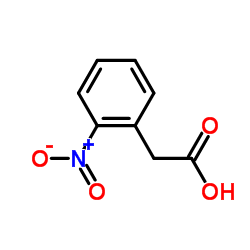(2-Nitrophenyl)acetic acid

(2-Nitrophenyl)acetic acid structure
|
Common Name | (2-Nitrophenyl)acetic acid | ||
|---|---|---|---|---|
| CAS Number | 3740-52-1 | Molecular Weight | 181.145 | |
| Density | 1.4±0.1 g/cm3 | Boiling Point | 345.1±17.0 °C at 760 mmHg | |
| Molecular Formula | C8H7NO4 | Melting Point | 137-140 °C(lit.) | |
| MSDS | Chinese USA | Flash Point | 155.9±9.4 °C | |
| Symbol |

GHS07 |
Signal Word | Warning | |
|
Studies on the catalytic behaviour of a cholinesterase-like abzyme in an AOT microemulsion system.
J. Biotechnol. 97(2) , 177-82, (2002) The hydrolytic activity of a monoclonal catalytic antibody (9A8) (abzyme) with acetylcholinesterase-like activity was investigated in water-in-oil (w/o) microemulsions (reverse micelles) based on sodium bis-2-(ethylhexyl)sulfosuccinate (AOT) in isooctane, usi... |
|
|
Molecular mechanism of uncaging CO2 from nitrophenylacetate provides general guidelines for improved ortho-nitrobenzyl cages.
ChemPhysChem 12(11) , 2077-80, (2011) Femtosecond spectroscopy and quantum chemical calculations provide detailed insights into the specificities of the uncaging mechanism of CO2 from ortho-, meta-, and para-nitrophenylacetate. The emerging general principles allow a rational design of improved o... |
|
|
Determination of the theophylline solubilizer salicylamide-O-acetic acid in serum and urine using high-performance liquid chromatography.
J. Pharm. Biomed. Anal. 3(5) , 469-75, (1985) A high-performance liquid chromatographic method for the determination of the theophylline solubilizer salicylamide-O-acetic acid has been developed in the range 0.5 to 10 microg/ml for human serum and 5 to 400 microg/ml for urine. Reversed-phase ion-pair chr... |
|
|
Mechanisms of cholinesterase inhibition by inorganic mercury.
FEBS J. 274(7) , 1849-61, (2007) The poorly known mechanism of inhibition of cholinesterases by inorganic mercury (HgCl2) has been studied with a view to using these enzymes as biomarkers or as biological components of biosensors to survey polluted areas. The inhibition of a variety of choli... |
|
|
Comparison of activation of CPT-11 by rabbit and human carboxylesterases for use in enzyme/prodrug therapy.
Clin. Cancer Res. 5(4) , 917-24, (1999) Several recent studies have examined the possibility of producing tumor-specific cytotoxicity with various enzyme/ prodrug combinations. The enzymes are targeted to tumor cells either with antibodies (ADEPT, antibody directed enzyme prodrug therapy) or with v... |
|
|
Leveraging a small-molecule modification to enable the photoactivation of rho GTPases.
ChemBioChem. 10(18) , 2855-7, (2009)
|